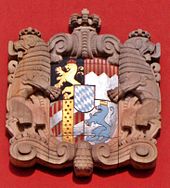Rudolf of Perignon


Rudolf Franz Xaver Perignon , Knight of Perignon since 1915 (born February 29, 1880 in Landstuhl , † September 17, 1959 in Pulling ) was a German architect and Bavarian construction officer . In 1920/24 he worked as a ministerial advisor in the Reich Treasury .
Life
He was the son of the teacher Joseph Perignon and his wife Barbara, nee Stadtmüller.
Perignon attended the Latin school in Landstuhl, graduated from the humanistic grammar school in Kaiserslautern and finally entered the Episcopal Konvikt in Speyer . He originally aspired to the priesthood, but then transferred to the Technical University of Munich , which he left as a graduate engineer and best among 52 candidates.
On October 1, 1905, Perignon entered Speyer as a one-year volunteer with the 2nd Pioneer Battalion of the Bavarian Army . Because of his architectural training, he was appointed to the Bavarian military construction site in Nuremberg in 1907 , in 1908 he was promoted to military construction inspector in Würzburg and on January 25, 1910 received the rank of lieutenant in the reserve . With the outbreak of World War I to the pioneers reactivated, it first took to the border skirmishes and in Lorraine Battle part. After the battles in front of Nancy - Épinal and on the Somme , Perignon was transferred to the 1st Field Engineer Company on November 1, 1914, and three weeks later to the 1st Field Engineer Company.
For his bravery and the construction of the attack position required for success in the storming of the high altitude of St. Eloi in February / March 1915, Perignon was awarded the Military Max Joseph Order on March 14, 1915 , the highest award for bravery in Bavaria . The award was connected with the elevation to the personal nobility and he was allowed to call himself Knight of Perignon after the entry in the nobility register .
In 1916 he was engaged in trench warfare in the Artois , took part in the battle of Arras in April / May 1917 and, as a first lieutenant in the reserve, participated in the following battles in Flanders , before Verdun , and at the Chemin des Dames . At the beginning of 1918 he was northwest of the Ailette and took part in the Great Battle of France at the end of March / beginning of April . On May 20, 1918, Perignon was transferred to his home country as head of the Munich III military building authority and last served as captain of the reserve on June 30, 1918 at the staff of the General of Pioneers.
After retiring from the army, President Friedrich Ebert appointed him Ministerialrat in the Reich Treasury in Berlin on August 20, 1920. He left this office on February 1, 1924 and worked as a freelance architect. At an advanced age he visited the Technical University of Munich again and in 1936 obtained a diploma in agriculture. He then ran an estate in Pulling near Freising, where he also spent his old age and died.
Perignon has always been active in this profession since his architectural degree; as a military architect in the civil service, but also mainly in the field of sacred architecture. In his home diocese of Speyer in particular , he designed several attractive churches, of which the parish church in Rockenhausen and the pilgrimage church on Maria Rosenberg in Waldfischbach-Burgalben are the most important. The most famous of his military buildings is the listed barracks of the 23rd Infantry Regiment in Kaiserslautern . In addition, Perignon also dealt with the interior decoration of churches, altars and the like. For the miraculous image of the Madonna von Pötsch in Kindsbach , he designed a splendid Art Nouveau frame made of metal, which is located together with the painting in the local Catholic church. From 1921 to 1923 the building of the Reichsfinanzhof, today the Bundesfinanzhof, in Munich was completed according to his plans. Perignon was an honorary citizen of his hometown Landstuhl .
literature
- Viktor Carl: Lexicon of Palatinate personalities. Hennig Publishing House. Edenkoben 2004. ISBN 3-9804668-5-X . P. 659.
- Clemens Jöckle: Rudolf von Perignons Catholic parish church in Rockenhausen. In: North Palatinate history sheets. 1980.
- Rudolf von Kramer, Otto von Waldenfels: The royal Bavarian military Max Joseph order. Self-published by the kb Military Max Joseph Order. Munich 1966. pp. 94, 373.
- Werner Weidmann: School, economic and social history of the Palatinate. Arbogast Publishing House. Kaiserslautern 2002. ISBN 3-87022301-4 . Volume 3, p. 85. Text excerpt on Rudolf von Perignon
Web links
- Entry in the historical register of architects archthek , accessed on August 22, 2010
- Website of the Pulling riding stables, with photo of Rudolf von Perignon's age , accessed on August 22, 2010
- Illustrated website for the Reichsfinanzhof in Munich , which Perignon expanded , accessed on August 22, 2010
- Website with picture of the parish church of St. Sebastian in Rockenhausen, one of the most famous buildings in Perignon , accessed on August 22, 2010
- Description of the church in Rockenhausen with the naming of Rudolf Perignon as the architect , accessed on July 19, 2014
- Website with picture of the St. Michael Church in Hütschenhausen designed by Perignon , accessed on August 22, 2010
Individual evidence
- ↑ Bavaria's Golden Book of Honor. Bavarian War Archives 1928. p. 40.
- ↑ The Federal Fiscal Court. Brochure from the Federal Fiscal Court. Retrieved January 26, 2019 .
| personal data | |
|---|---|
| SURNAME | Perignon, Rudolf von |
| ALTERNATIVE NAMES | Perignon, Rudolf Franz Xaver (birth name); Perignon, Rudolf Ritter von |
| BRIEF DESCRIPTION | German architect, Bavarian officer, knight of the Military Max Joseph Order |
| DATE OF BIRTH | February 29, 1880 |
| PLACE OF BIRTH | Landstuhl |
| DATE OF DEATH | 17th September 1959 |
| Place of death | Pulling |


